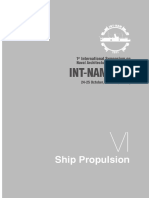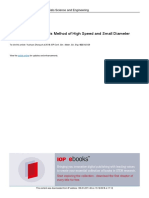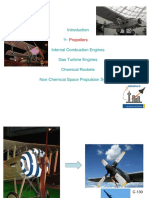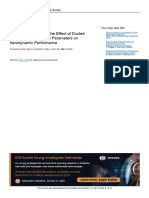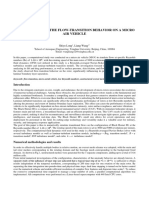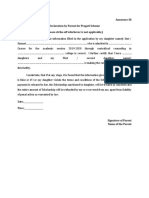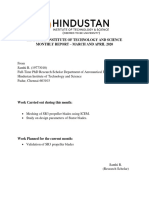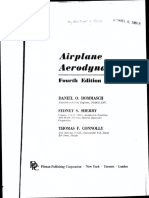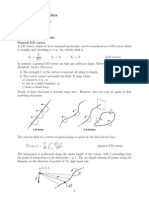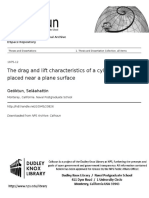GT2014 26779final
Uploaded by
SanthiGT2014 26779final
Uploaded by
SanthiSee discussions, stats, and author profiles for this publication at: https://www.researchgate.
net/publication/285592074
CFD Analysis of the Aerodynamics and Aeroacoustics of the NASA SR2 Propeller
Conference Paper · July 2014
DOI: 10.1115/GT2014-26779
CITATIONS READS
0 470
7 authors, including:
Wei Long Siauw
DSO National Laboratories
32 PUBLICATIONS 183 CITATIONS
SEE PROFILE
All content following this page was uploaded by Wei Long Siauw on 04 December 2015.
The user has requested enhancement of the downloaded file.
Proceedings of the ASME Turbo Expo 2014: Power for Land, Sea and Air
GT2014
June 16-20, 2014, Dusseldorf, Germany
GT2014-26779
CFD ANALYSIS OF THE AERODYNAMICS AND AEROACOUSTICS OF THE NASA
SR2 PROPELLER
Chun Hern Tan, Keng Soon Voo, Wei Long Siauw
DSO
Singapore
and
James Alderton, Amel Boudjir, Fred Mendonça
CD-adapco
London, UK
ABSTRACT downstream convection are well captured by judicious choice of
NASA’s SR2 8-bladed propeller rotating at 6487rpm mesh refinement in the wake of the propeller.
[1, 2, 3, 4] Advance Ratio of 3.06 and Mach Number of 0.6 is
used to assess the aerodynamic and noise performance
prediction capabilities of a standard commercial CFD code. INTRODUCTION
The main purpose of this study is to benchmark the Advances in computational aeroacoustic (CAA)
performance prediction against experimental data for Power methodologies and tools, in conjunction with the increase in
Coefficient and near-field noise measurements. Comparisons computational power have spurred the requirements for high
are made between single rotating and multiple rotating regions fidelity simulations and accurate predictions of airframe noise
across a sliding mesh interface. We also focus on the today.
effectiveness of capturing the downstream convection of tip As the pressure grows to use computational methods
vortex structures, in the wake of the propeller, modeled with all for aerodynamic performance, noise prediction and ultimately
8 blades, with a view towards using the approach to understand design analysis of aircraft propellers, there is clear need to
the interaction of these wake features with aerodynamic establish benchmarks and good practices. This is stimulated by
surfaces. the potential for reduced fuel consumption from single and
Noise predictions are performed using the standard counter-rotating open rotor designs, and the possibility to use
FfowcsWilliams-Hawkings impermeable surface method for virtual methods to reduce the inherent blade noise caused by
rotating dipoles. This is compared with near-field noise interaction with the airframe and propagation to the far-field
predictions using direct noise simulation from the unsteady (community noise). Interaction of the blade wake with airframe
compressible CFD code and experimental data, in terms of the surface for puller propeller configurations, or interaction on
measured dB intensity at the blade passing frequency and airframe wakes with the propeller in pusher configurations also
harmonics. requires a high modeling fidelity of wake structures.
Additional unsteady CFD simulation was conducted for a For the benchmark case, we have selected the NASA
separate SR2 propeller with a calibrated blade angle. The SR-2, 8-bladed propeller, rotating at 6487rpm [1, 2, 3, 4]. The
preliminary results of the direct near-field noise computation of aerodynamic and noise prediction capabilities of a standard
dB intensity at the blade passing frequency have shown commercial CFD code were assessed. The sensitivity of
improved agreement with wind tunnel data at aft angles to the geometry modelling and type of computational mesh domain,
propeller plane. (rotating cylinder and sliding mesh interface) were also
Practices are demonstrated which result in low dependency investigated.
on the sliding mesh interface location. Tip vortex structures and
1 Copyright © 2014 by ASME
Previously studies have been reported by de Gennaro [4]. The propeller configuration modeled here corresponds to
using commercial CFD and FfowcsWilliams-Hawkings M=0.6, with nominal advance ratio, J=3.06 defined by
impermeable surface acoustic propagation [5]. Only one blade
in the 8-bladed configuration was modeled resulting in a V
J (1)
reduced model size, and allowing for a single rotating frame nD
methodology to be used.
In this study, the full 8-bladed configuration has been
simulated, resulting in a model which is nominally 8 times COMPUTATIONAL SETUP
larger, but is still sufficiently practical to turn around with
reasonable computing resources in a reasonable time. The Geometry Generation
commercial code used here, STAR-CCM+ [6], has been
The SR2 propeller blade geometry data is depicted in
extensively benchmarked previously for three-dimensional
Figure 2. Geometrical parameters blade-width ratio (b/D), ideal
rotating machinery e.g. [7, 8], and validated for aeroacoustics
lift coefficient (CLD), design angle (∆β) and blade thickness
and noise propagation e.g. [9, 10, 11].
ration (t/b) are given as a function of blade fractional radius
(r/R). Data is provided for 24% to 100% of the blade span.
Below 24%, the blade is assumed to be mounted on an axis-
BENCHMARK EXPERIMENTAL SETUP
symmetric body and also the blade tip is assumed to be smooth
The experimental data for the study is obtained from
at 100% span.
the test conducted in the NASA Lewis Research Centre 8 by 6
The blade reference angle is 59 degrees, measured at
foot wind tunnel. The test set up used an axis-symmetric body
¾ blade span location. The blade angle along the span is
as a spinner where the propeller was mounted on. The
obtained by adding or subtracting the angles from the ∆β curve
propeller/spinner module was then mounted from the tunnel
to the reference design angle. The blade cross section profile
ceiling using a rear support. The transducers used in the
consists of a NACA65 2D section from root to 37% span, and a
acoustic measurement were installed on a separate flat plate
NACA 16 2D airfoil from 44% to the blade tip. A transition of
suspended from the tunnel ceiling at 0.3 propeller diameters
cross sections lies between 37% to 44% which is taken care of
away from the propeller tip, corresponding to roughly half a
by the CAD module in the pre-processor.
blade passing frequency wavelength away.
Figure 2: SR2 Blade Geometry Data (from References 1-4)
The following Figure 3 provides a description of the
respective parameters shown in the geometry profile graph.
Figure 1: Benchmark Experimental Setup in NASA Lewis Using the information provided segments of blade
Research Centre (from References 1-4) cross-sections are generated and used to form a complete blade
and with a generic axis-symmetric spinner hub. Approximations
A total of 12 transducers were installed along the plate are made from drawings (References [1-4]) as to the spinner
centreline, directly above the propeller centreline, and flushed nose shape and aft of the propeller since no detailed information
to the surface. A schematic of the tunnel set up as well as is given in any of the references. The detailed effects of the
relative transducer locations are shown in Figure 1. spinner nose shape are assumed to be negligible.
Measurements on this configuration range from tunnel
Mach Numbers of 0.6 to 0.8 and Advance Ratio of 2.75 to 3.85
2 Copyright © 2014 by ASME
Mesh Generation
For the different subsequent simulations, a similar
meshing topology was implemented. The mesh parameters are
as follows.
Mesh Type Trimmed hexahedral mesh with
prism layers
Cell Count Approximately 78 million cells
Base Size 10mm
Wall Y+ <1
Cell Refinement Surface Leading edge, trailing edge and
Figure 3: Description of Geometry Parameters, from blade tip
References [1-4] Cell Refinement Region Vicinity surround propeller hub
Table 1: Mesh Parameters
The completed CFD geometry is as shown in Figure 4.
The generated mesh is as shown in Figure 5. The
fundamental grid structure is chosen to be hexahedral, with
refinements of 2x2x2 in three dimensions approaching the
regions of interest especially close to the blade geometry to
capture the leading-edge and trailing-edge curvature. Close to
the surface, the hexahedral grid is trimmed to conform with the
curvilinear blade shape, from which prism layers are extruded
to capture the boundary layer down to y+<1 at the near-adjacent
layer. A base-cell dimension of 10mm is used for the entire
region surrounding the propeller and up to two propeller
diameters downstream of the propeller plane. Hexahedral cells
are perfectly suited to retain second-order spatial discretisation
accuracy in this region where the propulsive, acoustic and wake
effects are most important.
Figure 4: Completed SR-2 CFD CAD, top right and bottom,
compared with de Gennaro [5], top right
Figure 5: Complete CFD Mesh of 78 Million Cells
3 Copyright © 2014 by ASME
Simulation Domain Simulation Methodology
Figure 6 shows the test setup in the CFD simulation domain. Time accurate calculations are necessary to capture the
Pressure probes are placed at the exact same relative locations spectral content of aeroacoustic sources and interaction with the
to the propeller as the actual transducers in the tunnel. purely acoustical (resonance) features of the geometry. Noise
sources can be narrow-banded (tonal, such as arise from vortex
Microphone positions shedding) or broad-banded, arising from turbulent structures.
Transient calculations in general therefore should be run with
turbulence modelling which is “broad-band enabled”, should
work with fully compressible formulations and contain
boundary conditions which are non-reflective at the boundaries
of the computational domain. The flow should be boundary-
layer resolved to ensure adequate capture of near-wall adverse
pressure-gradient induced separation in smoothly curved
geometries. Second-order time discretisation is used in this
study.
Turbulence modelling
Figure 6: Schematic of Simulation Domain and Experimental DES, with the underlying RANS turbulence model
Setup based on the low-Reynolds number two-equation k-ω-SST
The pressure probes in the simulation are located in a free field model is used in the present study; full formulations are given in
as compared to that in the plate mounted transducers used in the Mendonça [10]. Also described therein is a near-wall
experiment. There would be certain extent of influence on the momentum treatment which is independent of near-wall y+
results due to boundary layer refraction on the acoustic plate. resolution. Here, formulations are implemented which return the
However, this impact on the results is not expected to be correct wall shear behaviour anywhere in the wall-adjacent
significant. The use of an acoustic plate considerably reduces layer range 0 < y+ < 300.
the thickness of the boundary layer due to the short
development length as compared to the tunnel walls as Compressibility
described in [4]. Flows in ducts, cavities and resonators potentially give
Two different meshing approaches are investigated, rise to important interaction between periodic flow features and
namely the Fully Rotating and Sliding Interface mesh domain as the acoustics associated with the geometry. In these cases it is
depicted in Figure 7. In the fully rotating mesh, both the necessary to include compressibility in the CFD formulation
propeller and the far field free stream are located within a single that is to be able to capture directly the interaction of
region, which rotates entirely during the simulation. For the propagating pressure waves with the flow and turbulence. For
sliding mesh, the simulation domain consists of 2 different second-order accurate codes such as used here, at least 20 cells
regions connected with a sliding interface. The inner region per acoustic wavelength are required to propagate an acoustics
contains the propeller which rotates at the desired rpm, and signal in space with negligible dissipation of the acoustic
another outer region which remains stationary during the energy.
simulation. The flow field information is transmitted from the A similarly important requirement in compressible
inner region to the outer region where the microphone probes flow is to ensure that far field inflows and outflows boundaries
are located via an internal sliding interface. are non-reflective. Reflective boundaries can cause artificial
acoustical resonance in the computational domain and should
be avoided. In this case, a non-reflective treatment is applied at
the wind-tunnel inlet and outlet. The stream-wise Mach number,
pressure and temperature are fixed, from which compressible
characteristics to be computed at the boundary face.
Rigid body mesh motion is applied to the cells inside
the rotating volume adjacent to the wheel surfaces. The static-
rotating sliding interface is the same interface as was used for
the mixing plane steady-state analysis. At each time step, the
mesh in the rotating region is rigidly rotated by 1 o.
Fully Rotating Sliding Interface
Acoustic Analogy
Figure 7: Schematic of Fully Rotating vs Sliding Interface To compare with the direct acoustic approach obtained
Mesh Setup by solving second-order spatial/temporal compressible flow, the
4 Copyright © 2014 by ASME
FfowcsWilliams-Hawkings (Fw-h) analogy [11] for Each simulation was first computed in a steady state
impermeable surfaces of Brentner and Farasat [12] is used, and manner using RANS until a stable solution was attained and
the specific implementation in the code is described in Caraeni then switched to transient simulation (DES). The transient
[13]. simulation is computed for several propeller rotations to attain
We note here that there are many fundamental sufficient statistically converged data for analysis.
differences between the direct approach and Fw-h approach
applied in this study. In the former, all tunnel walls are assumed S/N Configuration Mesh Domain Blade Blade Profile
to be rigid, and therefore reflective – the direct approach Angle (Root/Tip)
therefore adds contributions from “mirrored” propellers on the 1 SR2_59_Rot_A Fully Rotating 59 deg 65(2)-215/16-006
opposite side of the tunnel walls, and is exactly analogous to the 2 SR2_59_Slide_A Sliding interface 59 deg 65(2)-215/16-006
measurements. The latter approach, however, accounts only for 3 SR2_59_Rot_B Fully Rotating 59 deg 65-010/16-103
the noise radiated from the single propeller source enclosed by
the impermeable blade surfaces in the simulated domain, and is 4 SR2_59.5_Rot_B Fully Rotating 59.5 deg 65-010/16-103
therefore expected to underestimate the measurements (and also Table 2: Simulation Configurations Investigated
direct noise prediction).
Conversely, Fw-h propagates efficiently to arbitrary
observer locations in the far-field, whereas the direct approach
Parameters Value
will suffer from diffusion of the acoustical signal due to a
Free stream Mach 0.6
coarsening of the cells between the source region and
Propeller Diameter (scaled wind tunnel model) 0.622m
microphone locations. Therefore under-prediction of the
directly propagated acoustic field is expected for higher Advance Ratio 3.06
harmonics where the respective wavelengths would be under- Table 3: Simulation Conditions for Validation Study
resolved with the current grid size. A further uncertainty with
respect to comparison of the measured and predicted acoustic The acoustic field is extracted using both direct
data may arise because the simulation domain modeled only the pressure measurement and through Fw-h acoustic model. The
test section portion of the wind tunnel. The propeller blade surfaces are chosen to be the impermeable Fw-h
upstream/downstream flow and acoustic termination conditions surface to model the dominant rotating-dipoles. The Fw-h
were not known and hence were modeled as free-stream and receiver probes are located at the same locations as the
acoustically non-reflective. respective microphone probes in the wind tunnel test.
Finally, it is worth noting that direct simulation For the transient simulation, a second-order time-
requires appropriate resolution of many scales; for acoustical stepping with interval of 2.5x10-5s is used to capture a blade
propagation, aerodynamic blade loading and volume-based rotation of approximately 1 degree per time step. 10 internal
(quadrupole) flow structures. We are confident that the near- iterations are used to allow the residuals within each time step
field acoustic propagation and blade loading at least up to the to be reduced by at least 2 orders for convergence. We further
blade-passing frequency are satisfied. However, further analysis monitor the pressure change per iteration at each microphone
is required to be confident that all volume-based flow structures monitor location to ensure that the pressure has converged (is
which contribute to noise at the frequency range of interest are unchanging) at the end of the time-step. On the 78million cell
captured. Contribution will affect both the direct noise model, one full rotation takes 2250 CPU-hours.
simulation and Fw-h; for the latter, a permeable surface
treatment would be necessary to account for volume-based
sources. This is discussed later, and will form the basis of future RESULTS AND DISCUSSION
work. Experimental data for the Power Coefficient (CP) and
near-field noise measurements from the transducers are used as
Simulation Configuration the benchmark parameters for the various CFD and aero-
Table 2 outlines the various simulation runs which acoustics techniques.
have been computed in the validation study. The validations
performed in this study focus on investigating the dependencies Steady State Power Coefficient
on CFD variables for propeller modelling namely simulation The steady state parameters provide a preliminary
domain, propeller geometry and modelling sensitivity. The estimate for the accuracy of the various modelling approach and
objective of these studies is to develop outline of the approach is compared against experimental data. The experiment power
towards the modelling and prediction of propeller noise. coefficient is given by
The test condition chosen for validation is shown in
the following Table 3. P
CP (2)
0 n3 D5
5 Copyright © 2014 by ASME
The power delivered is obtained from the steady state measurement under-predicted the measured blade passing
computation from the propeller torque, Q, and using the relation frequency sound pressure level (BPF SPL). This suggests that
the aerodynamic results may not be directly correlated to the
P 2nQ (3) sound pressure levels. This observation is further discussed in
the later sections.
Table 4 shows the coefficient of power, CP, from the Looking at the noise predicted by the Fw-h model and
respective simulations. direct measurement in Figure 8, we observe that the results
agree well in the locations downstream of the propeller plane.
Configuration Description Coefficient of Power, Cp
Upstream from the propeller plane, the Fw-h predicts a lower
sound pressure level from the direct measurement. Possible
Experiment 1.32 reasons for this under-prediction were discussed earlier.
SR2_59_Rot_A 1.59
SR2 _59_Slide_A 1.58 SR2 _59_Slide_A
SR2_59_Rot_B 1.20
Here, the same simulation is conducted using a domain
SR2_59.5_Rot_B 1.325 which is more representative of the tunnel test section setup
Table 4: Comparison of Steady State Power Coefficient where the tunnel wall is modeled as well. From the results
presented in Figure 9, we observe a similar trend as in the fully
SR2_59_Rot_A rotating domain. Again, there is better agreement between the
This configuration corresponds to an artificial domain two noise prediction approaches downstream of the propeller
in so far as the tunnel walls are not modeled. The computed plane and a higher prediction of noise by direct pressure
BPF data compared with measurements is shown in Figure 8. measurement at the upstream locations.
For consistency’s sake, the data for all the simulations were At the same time however, we observe that the Fw-h
extracted across a fixed physical time duration of 0.056 seconds fully-rotating and sliding-domain results are close to identical
(approximately 6 complete propeller rotations) and the spectral (as expected), whereas the direct pressure simulation in the
analysis were conducted for the data using 2 blocks and 50% sliding-domain approach predicts higher noise than in the fully
overlap factor, corresponding to ~36Hz resolution. rotating domain. This could be due to the simulation using a
Noise predictions are performed using the standard more realistic domain including the wind-tunnel tunnel walls.
FfowcsWilliams-Hawkings (Fw-h) impermeable surface method
for rotating dipoles. This is compared with direct near-field
noise computation from the unsteady CFD code itself, as well as
experimental data of the dB intensity at the blade passing
frequency in the wind tunnel.
Figure 9: Noise Prediction for Simulation Configuration
SR2_59_Slide_A
Fully Rotating vs Sliding Interface domain
Figure 8: Noise Prediction for Simulation Configuration Here a detailed comparison is made between the
SR2_59_Rot_A results from the two different mesh domains to assess the mesh
influence on the simulation results.
From the steady-state (converged, pre-transient DES
computation) in Table 4, we observe that the CP was over-
predicted. However, both the Fw-h and direct pressure
6 Copyright © 2014 by ASME
Steady State Power Coefficient at the interface, which is at a frequency an order of magnitude
From Table 4, both the simulations have predicted very larger than the BPF.
similar steady state coefficient of power. This indicates that any
artificial disturbance from numerical interpolation across the
sliding interface is negligible when considering aerodynamic
force-based predictions as suggested in the previous section.
For the two simulations, the choice of blade profile
from the NACA 65- and NACA 16- families have yet to be
investigated. Hence this initial selection of airfoil was simply
based on their availability from the online database. In
subsequent simulations presented next, another set of airfoil
profile were used to investigate their respective influence on the
simulation results.
Noise Prediction
The sound pressures computed from the Fw-h and
direct pressure measurements from the two simulations are Figure 11: Direct Measurement Noise Prediction Comparison
compared in Figures 10 and 11. for Rotating and Sliding Interface Mesh Domain
In view of these differences, subsequent comparison
sets of simulation were conducted using the fully rotating mesh
domain.
SR2_59_Rot_B
In this set of simulation, a new set of blade profile is
selected for the blade root and blade tip and the results are
shown in Figure 12. Based on the geometry data provided in
Figure 2, we have chosen the blade profile that best matches the
average blade design lift coefficient in the root and tip
segments. Hence NACA 65-010 is chosen for a zero-lift
coefficient and NACA 16-103 is chosen with a lift coefficient of
0.1, in order to better represent the actual SR2 blade model in
the experiment.
Figure 10: Fw-h Noise Prediction Comparison for Rotating
and Sliding Interface Mesh Domain
The noise prediction from both mesh domains by the
Fw-h model is clearly identical, which suggests that this noise
prediction approach is insensitive to the mesh domains as it
only resolves the pressure fluctuations on the impermeable
blade surfaces.
The comparison between the sound pressure levels
obtained from direct pressure measurements in the 2
simulations in Figure 11 showed an overall over-prediction of
sound pressure level from the sliding mesh domain which was
not present in the Fw-h measurements. This supports the earlier
suggestion that extra noise captured here is due to differences in
domain (cylinder and rectangular tunnel walls behave Figure 12: Noise Prediction for Simulation Configuration
acoustically differently). We discount any possibilities due to SR2_59_Rot_B
sliding mesh interpolation practices for two reasons; second-
order discretization practices continue to be used at the The steady simulation showed that a power coefficient
interface, and errors of higher than second-order will occur at of 1.2 was obtained with the new blade profiles in Table 4. The
wavelengths at wavelengths approximately equal to the cell-size significant change in steady state results indicated that the
7 Copyright © 2014 by ASME
choice of blade profile has a major influence on the were not modeled or captured in the simulation. We revisit the
aerodynamic predictions of the propeller. A direct approach to initial assumption of dipole-dominance in the volume
improve the steady state prediction would be to increase the displacement and thickness noise sources. Through the use of
accuracy of blade modeling by using more different blade impermeable Fw-h surfaces, we have directly omitted the
profiles for smaller segments of the blade to adhere closer to the acoustic contribution of any volumetric quadrupole sources in
different design lift coefficients. However, in practical the flow and hence possibly leading towards the under-
scenarios, the accuracy of the blade profiles is limited by prediction of sound pressure levels. A permeable-surface Fw-h
manufacturing precision. An alternate way would be to treatment would be needed to account for quadrupole sources.
selectively adjust the blade pitch angle setting to attain the To attribute the un-captured noise sources to
desired steady state performance [5] to account for geometrical volumetric quadrupoles, we would have to consider their
distortion due to physical loading present in the experiment. relative acoustic contribution in this scenario. For moderately
Hence in the next set of simulation, the blade angle subsonic or fully supersonic flow over thin blade sections, the
setting is increased arbitrarily by 0.5 degree to 59.5 degrees to quadrupole term could be considered negligible. However, it
attain a better steady state comparison with the experimental was shown by Fink, [14] that there is significant quadrupole
data. The results are shown in the following Figure 13. noise radiation in the transonic regime. The following graph
shows the acoustic contribution of quadrupole sources relative
SR2_59.5_Rot_B to the dominant dipole sources across the transonic regime.
Figure 13: Noise Prediction for Simulation Configuration
SR2_59.5_Rot_B
The steady simulation showed that a Power Coefficient
of 1.325 was obtained which is in good agreement with
experimental results of CP = 1.3, which has improved greatly
from the original steady state results of CP = 1.58 - 1.59.
However, there is still no apparent improvement in the
noise prediction by both the Fw-h model and direct
measurement approach. The same trends are present in Figures
12 and 13. The sound pressure levels in both simulations are
under-predicted as well. There is also a better agreement in the Figure 14: Relative Acoustic Contribution of Quadrupoles at
noise prediction downstream of the propeller plane as compared Different Transonic Mach Regimes, from Reference [14]
to the upstream locations between the two simulations. This
trend is identical to that of the previous set of simulations with From Figure 14, it is shown that quadrupole sources
the old blade profiles, and suggests that the correlation between are non-negligible across the transonic regime, contributing as
the power and noise at the BPF for this propeller is weak. much as up to 90% of acoustic strength as that of the surface
dipoles. Figure 15 show the respective additional decibels
Correction for non-linear quadrupole sources contributed by the quadrupole sources across the transonic
From the aforementioned set of results, it is shown that regime up to a maximum of 5.7dB at about Mach 0.95.
the under-prediction of sound pressure levels is not due to the Next, we examine the velocity regime across the
mesh or geometrical modeling deviations. Another area which propeller blade surfaces from the simulation. The velocity
has yet to be considered would be that certain noise sources contour is displayed at two blade sections, located at 30% (A)
8 Copyright © 2014 by ASME
and 90% (B) of span in Figure 16. The relative Mach number For illustration only, the 5.7dB correction factor is
increases along the span direction and the flow field becomes arbitrarily applied to the Fw-h sound pressure level of the
locally supersonic at the upper part of the propeller section B. calibrated blade simulation and shown in the Figure 17 to
Hence it is evident that a full transonic regime exists along a illustrate the possible effect of quadrupole source contribution.
section of the blade which necessitates the application of a
5.7dB correction to the sound pressure level measured.
Figure 17: Quadrupole-Corrected (indicative only) Sound
Pressure Level for SR2_59.5_Rot_B
We see an improvement in the agreement with
experimental results, especially at the peak tonal noise level at
probe number 6, which lies closest to the propeller plane. A
similar improvement in agreement is achieved as well when the
quadrupole noise source contribution correction was applied in
the data in (Fink, 1979), shown in Figure 18.
At the same time we reiterate, as discussed earlier, that
the direct noise simulation increases the dB-level compared to
Fw-h, and that the volume source resolution is still un-validated.
Figure 15: Additional Sound Pressure Level to be considered These will be the subject of further investigations.
for Quardupole Noise, Reference [14]
Figure 18: Comparison of Sound Pressure Level Corrected for
Quadrupoles with Experiment, Reference [14]
Figure 16: Local Mach Contours at Different Blade Segments
9 Copyright © 2014 by ASME
Overall Sound Pressure Level FUTURE CONSIDERATIONS
Finally, we take a brief look at the comparison of the
corrected sound pressure level at the blade passing frequency The simulation would be re-examined, to assess the
with the overall sound pressure level measured across the approach to capture the omitted noise sources. In order to
frequency spectrum in Figure 19. capture the volumetric noise sources, a mesh refinement would
be required to capture the convection and development of small
scaled structures downstream of the propeller plane. At the
same time, a permeable Fw-h surface would be implemented as
well to model the propagation of both surface and volume
sources. Here, the influence of the choice of permeable
volumetric region on the noise captured would be investigated
as well.
CONCLUSION
Aerodynamic performance and noise predictions from
these computations on the full 8-bladed propeller are consistent
with previous public-domain studies [5] performed on
simplified single blade representations and experimental data.
Figure 19: Comparison of Blade Passing Frequency SPL with Additional unsteady CFD was conducted for a separate SR2
Overall SPL propeller with a calibrated blade angle. The preliminary results
of the direct near-field noise computation of dB intensity at the
The comparison have shown that the sound pressure blade passing frequency have shown improved agreement with
level is very much dominated by the pressure fluctuations at the wind tunnel data at aft angles from the propeller plane.
blade passing frequency in the vicinity of the propeller plane, as We demonstrated practices which result in low
shown by the close match of the plots from probes 4 to 9. At dependency on the sliding mesh interface location. Tip vortex
both up and downstream away from the propeller plane, the structures and downstream convection are well captured by
contributions of noise from the sub and higher harmonic judicious choice of mesh refinement in the wake of the
spectrums become more apparent as shown by the higher propeller. Finally, the blade angle variation study illustrates how
OASPL from probes 1 to 3 and 10 to 12. steady-state computations may be used to capture the trends in
noise levels towards noise design analysis.
Blade Tip Vortex Structures Comparisons are made between single rotating and
multiple rotating regions across a sliding mesh interface. We
Lastly, we take a look at effectiveness of the simulation
also focused on the effectiveness of capturing the downstream
in capturing the downstream convection of tip vortex structures,
convection of tip vortex structures, in the wake of the fully
in the wake of the fully modelled 8-blade propeller. Figure 20
modelled 8-blade propeller, with a view towards understanding
shows the iso-surface of vorticity in the vicinity of the propeller.
the interaction of these wake features with aerodynamic
It is apparent that the coherent swirling vortical structures
surfaces or structures downstream.
generated by the rotating blade tips are very well captured by
the simulation.
NOMENCLATURE
BPF - Blade passing frequency
Fw-h - FfowcsWilliams-Hawkings
rpm - rotations per minute
V - free stream velocity (ms-1)
n - propeller revolution per seconds
D - propeller diameter (m)
M - Mach Number
CP - Coefficient of Power
Figure 20: SR2 Blade Tip Vortex Structures
P - Propeller power (W)
ρ0 - free-stream density (kg.m3)
Q - Torque (N.m)
10 Copyright © 2014 by ASME
REFERENCES [12] Brentner K. S. and Farassat F. "Analytical Comparison of
the Acoustic Analogy and Kirchho¤ Formulation for
[1] D.C. Mikkelson D.C., Blaha B.J. , Design and moving Surfaces", AIAA Journal, Vol. 36 (8), (1998),
Performance of Energy Efficient Propellers for Mach pp. 1379-1386.
0.8 Cruise, NASA TMX-73612, (1977)
[13] Caraeni M., Aybay O., Holst S., Tandem Cylinder and
[2] Jaracki R.J., Mikkelson D.C., Blaha B.J., Wind Tunnel Idealized Mirror Far-Field Noise Predictions Using DES
Performance of Four Energy Efficient Propellers, and an Efficient Implementation of FW-H Equations,
Designed for Mach 0.8 Cruise, NASA TM-79124 (1979) AIAA2011-2843, 17th AIAA/CEAS Aeroacoustics
Conference, 5-8th June, Portland, Oregon (2011)
[3] Stefko G.L., Jaracki R.J., Wind Tunnel Results of
Advanced High Speed Propellers in the Takeoff, Climb [14] Fink D. B., The Importance of Quadrupole Sources in
and Landing operating Regimes, NASA TM-87054 Prediction of Transonic Tip Speed Propeller Noise,
(1985). Journal of Sound and Vibration , 19-38 (1979).
[4] Dittmar J.H., Cruise Noise of the SR2 Propeller Model in
a Wind Tunnel, NASA TM-101480 (1989).
[5] De Gennaro M., Caridi D., Pourkashanian M., Ffowcs
Williams-Hawkings Acoustic Analogy for Simulation of
NASA SR2 Propeller Noise in Transonic Condition,
ECCOMAS CFD 2010 Conference, ID 1364 pp.1-16,
ISBN: 978-989-96778-1-4, Lisbon (Portugal) June 2010.
[6] STAR-CCM+ release v8, CD-adapco, 2013
[7] Davison J., Ferguson S., Mendonça F., Peck A., Towards
an automated simulation process in combined Thermal,
Flow and Stress in Turbine Blade Cooling Analysis,
GT2008-51287, ASME Turbo Expo, Berlin, 2008
[8] Baris O., Mendonça F., Automotive turbocharger
compressor CFD and extension towards incorporating
installation effects, GT2011-46796, Proceedings of ASME
Turbo Expo 2011, Vancouver, Canada.
[9] Mendonca F., Baris O., Capon G., Simulation of Radial
Compressor Aeroacoustics using CFD, GT2012-70028,
Proceedings of ASME Turbo Expo 2012, GT2012,
Copenhagen, Denmark
[10] Mendonça F., Chapter on Industrial Aeroacoustics
Analyses in LES for Acoustics, Cambridge University
Press, 2007, ISBN: 978-0-521871-44-0
[11] Ffowcs Williams J. and Hawkings D., "Sound Generation
by Turbulence and Surfaces in Arbitrary Motion",
Philosophical Transactions of the Royal Society of
London, Series A, Mathematical and Physical Sciences
(1934-1990), Vol. 264 (1151), pp.321-342, 1969.
11 Copyright © 2014 by ASME
ANNEX A
PUT ANNEX TITLE HERE
Put text of Annex here
12 Copyright © 2014 by ASME
View publication stats
You might also like
- High Energy Laser (Hel): Tomorrow’S Weapon in Directed Energy Weapons Volume IFrom EverandHigh Energy Laser (Hel): Tomorrow’S Weapon in Directed Energy Weapons Volume INo ratings yet
- Research Article: CFD Analysis of Contrarotating Open Rotor Aerodynamic InteractionsNo ratings yetResearch Article: CFD Analysis of Contrarotating Open Rotor Aerodynamic Interactions14 pages
- Aerodynamic Performance Characterization and Structural Analysis of Slotted Propeller: Part A Effect of PositionNo ratings yetAerodynamic Performance Characterization and Structural Analysis of Slotted Propeller: Part A Effect of Position17 pages
- Yauwenas Et Al (2019) - The Effect of Inflow Disturbance On Drone Propeller NoiseNo ratings yetYauwenas Et Al (2019) - The Effect of Inflow Disturbance On Drone Propeller Noise17 pages
- JBLADE: A Propeller Design and Analysis Code: C C F C C C B R A A L WNo ratings yetJBLADE: A Propeller Design and Analysis Code: C C F C C C B R A A L W12 pages
- A_systematic_comparison_between_RANS_andNo ratings yetA_systematic_comparison_between_RANS_and13 pages
- 2021-Aerodynamic Analysis of Quadrotor UAV Propeller Using Computational Fluid DynamicNo ratings yet2021-Aerodynamic Analysis of Quadrotor UAV Propeller Using Computational Fluid Dynamic5 pages
- Experimental Investigation of UAV Rotor Aeroacoustics and Aerodynamics With Computational Cross ValidationNo ratings yetExperimental Investigation of UAV Rotor Aeroacoustics and Aerodynamics With Computational Cross Validation16 pages
- Development of A CFD Model For Propeller Simulation: Lodz University of TechnologyNo ratings yetDevelopment of A CFD Model For Propeller Simulation: Lodz University of Technology16 pages
- Clarke Botero 2023 Aeroacoustic Optimization of Vtol Rotor BladesNo ratings yetClarke Botero 2023 Aeroacoustic Optimization of Vtol Rotor Blades20 pages
- A Study of the Efficiency of Toroidal Propeller DesignsNo ratings yetA Study of the Efficiency of Toroidal Propeller Designs25 pages
- Noise and Performance of Propellers For Light AircNo ratings yetNoise and Performance of Propellers For Light Airc27 pages
- Acoustic and Aerodynamic Evaluation of DLR Small-SNo ratings yetAcoustic and Aerodynamic Evaluation of DLR Small-S22 pages
- WB2-2-Di Felice - Numerical and Experimental Analysis of the Wake BehaNo ratings yetWB2-2-Di Felice - Numerical and Experimental Analysis of the Wake Beha7 pages
- A Performance Analysis Method of High Speed and SM PDFNo ratings yetA Performance Analysis Method of High Speed and SM PDF7 pages
- A Performance Analysis Method of High Speed and Small Diameter PropellerNo ratings yetA Performance Analysis Method of High Speed and Small Diameter Propeller7 pages
- Internal Combustion Engines Gas Turbine Engines Chemical Rockets Non-Chemical Space Propulsion SystemsNo ratings yetInternal Combustion Engines Gas Turbine Engines Chemical Rockets Non-Chemical Space Propulsion Systems49 pages
- Airplane Propellers Aerodynamic Design and Performances AnalysisNo ratings yetAirplane Propellers Aerodynamic Design and Performances Analysis7 pages
- Numerical Analysis of The Effect of Ducted Propeller Configuration Parameters On Aerodynamic PerformanceNo ratings yetNumerical Analysis of The Effect of Ducted Propeller Configuration Parameters On Aerodynamic Performance10 pages
- Afari Mankbadi 2023 Simulations of Multi Rotor Interaction Noise at Hovering Forward Flight ConditionsNo ratings yetAfari Mankbadi 2023 Simulations of Multi Rotor Interaction Noise at Hovering Forward Flight Conditions35 pages
- Blue Edge: The Design, Development and Testing of A New Blade ConceptNo ratings yetBlue Edge: The Design, Development and Testing of A New Blade Concept14 pages
- 2022 - Azadeh Sajedin - Flutter, Aerolastic Instability, Fourier Trasnformation, Turbocharger, Aerodynamic DampingNo ratings yet2022 - Azadeh Sajedin - Flutter, Aerolastic Instability, Fourier Trasnformation, Turbocharger, Aerodynamic Damping16 pages
- olichevis-halila-et-al-2022-efficient-aerodynamic-analysis-for-propeller-aircraft-including-viscous-effectsNo ratings yetolichevis-halila-et-al-2022-efficient-aerodynamic-analysis-for-propeller-aircraft-including-viscous-effects19 pages
- Aeroacoustic and Aerodynamic Optimization of Propeller BladesNo ratings yetAeroacoustic and Aerodynamic Optimization of Propeller Blades14 pages
- 2011 - Nigel Peak - Noise, Turbofan, Propeller, Open RotorNo ratings yet2011 - Nigel Peak - Noise, Turbofan, Propeller, Open Rotor24 pages
- A Multi-Objective Approach For Determining The Num PDFNo ratings yetA Multi-Objective Approach For Determining The Num PDF18 pages
- Analysis of Propeller-Airframe Interaction Effects Through A CombinedNo ratings yetAnalysis of Propeller-Airframe Interaction Effects Through A Combined19 pages
- Parametric Research and Optimization of Ducted Propeller Aerodynamic ConfigurationNo ratings yetParametric Research and Optimization of Ducted Propeller Aerodynamic Configuration10 pages
- 3D Inviscid Flutter of Rotor Blades and Stator/Rotor Stage: Romuald Rządkowski Vitaly GnesinNo ratings yet3D Inviscid Flutter of Rotor Blades and Stator/Rotor Stage: Romuald Rządkowski Vitaly Gnesin12 pages
- Comparative Study of Ducted and Unducted PropellerNo ratings yetComparative Study of Ducted and Unducted Propeller9 pages
- Rotor Aeroacoustic Response to an Axisymmetric TurNo ratings yetRotor Aeroacoustic Response to an Axisymmetric Tur33 pages
- Research and Design of Snow Hydrology Sensors and Instrumentation: Selected Research PapersFrom EverandResearch and Design of Snow Hydrology Sensors and Instrumentation: Selected Research PapersNo ratings yet
- CartoMobile iPhone/iPad App: Optimize Ground Survey Data Collection for Airborne LIDAR Accuracy AssessmentFrom EverandCartoMobile iPhone/iPad App: Optimize Ground Survey Data Collection for Airborne LIDAR Accuracy AssessmentNo ratings yet
- Annexure-III Declaration by Parent For Pragati Scheme (Please Strike Off Whichever Is Not Applicable)No ratings yetAnnexure-III Declaration by Parent For Pragati Scheme (Please Strike Off Whichever Is Not Applicable)1 page
- Hindustan Institute of Technology and Science Monthly Report - March and April 2020No ratings yetHindustan Institute of Technology and Science Monthly Report - March and April 20204 pages
- Hindustan Institute of Technology and Science: School of Aeronautcial SciencesNo ratings yetHindustan Institute of Technology and Science: School of Aeronautcial Sciences35 pages
- An Investigation of Tip Vortices Unsteady Interaction For Fokker 29 Propeller With Swirl Recovery VaneNo ratings yetAn Investigation of Tip Vortices Unsteady Interaction For Fokker 29 Propeller With Swirl Recovery Vane12 pages
- A Numerical Investigation of The 3D Swirling Flow in A Pipe With Constant Diameter. Part 2: Turbulent ComputationNo ratings yetA Numerical Investigation of The 3D Swirling Flow in A Pipe With Constant Diameter. Part 2: Turbulent Computation10 pages
- Twisted Photons Applications of Light with Orbital Angular Momentum First Edition Juan P. Torres download100% (2)Twisted Photons Applications of Light with Orbital Angular Momentum First Edition Juan P. Torres download63 pages
- Design Rules For Aerodynamic Effects On Bridges100% (1)Design Rules For Aerodynamic Effects On Bridges46 pages
- CFD Simulation of Precession in Sudden Pipe Expansion Ows With Low Inlet SwirlNo ratings yetCFD Simulation of Precession in Sudden Pipe Expansion Ows With Low Inlet Swirl15 pages
- Taylor-Vortex Membrane Reactor For Continuous Gas-LiquidNo ratings yetTaylor-Vortex Membrane Reactor For Continuous Gas-Liquid11 pages
- An Introduction To Vortex Ows - Theoretical Hydrodynamic Vortex BehaviourNo ratings yetAn Introduction To Vortex Ows - Theoretical Hydrodynamic Vortex Behaviour2 pages
- United States Patent (19) 5,022,984: Pimley Et Al. Jun. 11, 1991No ratings yetUnited States Patent (19) 5,022,984: Pimley Et Al. Jun. 11, 199111 pages
- Investigation of Sediment Entrainment in Brownout Using High-Speed Particle Image VelocimetryNo ratings yetInvestigation of Sediment Entrainment in Brownout Using High-Speed Particle Image Velocimetry9 pages
- (Swanson 1961) Swanson Magnus Effect Review Paper100% (1)(Swanson 1961) Swanson Magnus Effect Review Paper10 pages
- Aerodynamic Characterisation of A 2-D Flapping Wing Using CFD TechniqueNo ratings yetAerodynamic Characterisation of A 2-D Flapping Wing Using CFD Technique89 pages

















